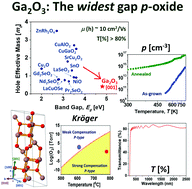Enhancing the intrinsic p-type conductivity of the ultra-wide bandgap Ga2O3 semiconductor
Abstract
While there are several n-type transparent semiconductor oxides (TSO) for optoelectronic applications (e.g. LEDs, solar cells or display TFTs), their required p-type counterpart oxides are known to be more challenging. At this time, the n-type TSO with the largest bandgap (∼5 eV) is Ga2O3 that holds the promise of extending the light transparency further into the deep ultraviolet. In this work, it is demonstrated that strongly compensated Ga2O3 is also an intrinsic (or native) p-type TSO with the largest bandgap for any reported p-type TSO (e.g. NiO, SnO, delafossites, oxychalcogenides). The achievement of hole mobility in excess of 10 cm2 V−1 s−1 and (high temperature) free hole concentrations in the ∼1017 cm−3 range challenges the current thinking about achieving p-type conductivity in Ga2O3 being “out of the question”. The results presented in this paper therefore further clarify that p-type Ga2O3 is possible, although more research must be conducted to determine what are the real prospects for Ga2O3 solar blind bipolar optoelectronics and ultra-high power electronics based on p–n homojunctions.



 Please wait while we load your content...
Please wait while we load your content...